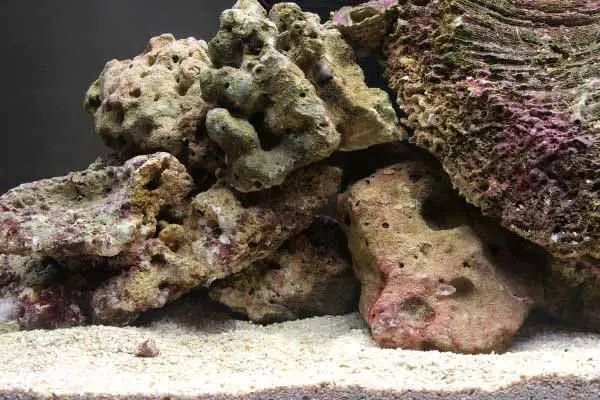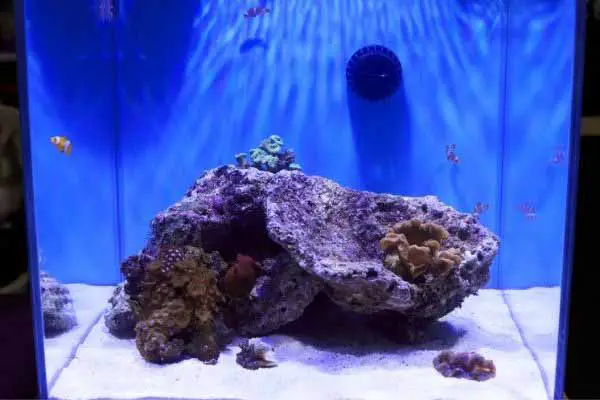Live rock aquarium needs often puzzle aquarists. How much to include in a new saltwater aquarium? It’s one of the most common questions new aquarists ask. And you might be surprised to find out you really only need 10-20 pounds of this expensive reef substrate – no matter how big of an aquarium you have. Don’t believe me? Not to worry, we’ll get into how to determine your live rock aquarium needs throughout this article.
Table of Contents: Live Rock Aquarium Needs
Figuring out your live rock aquarium needs may sound tricky. And when it comes to doing the math (yes, math), you may want to avoid the question altogether and hope a best-guess scenario will do the trick. For the health of your aquarium – and all of the fish and invertebrates you’re keeping around – do yourself a favor and stick with me here. But, if you want to skip down and only read up on the math part, these handy links will allow you to do so.
- What is Live Rock?
- Calculating Live Rock Aquarium Needs
- What About Live Sand?
- Conclusions
- For More Information

What is Live Rock?
The question: “What is live rock” usually comes before the notion of live rock aquarium needs. Because, quite frankly, the term seems to make no sense. Whoever heard of a LIVE rock? Rocks aren’t alive – it’s what sets them apart from…well, everything that’s not a rock. Doesn’t it?
When we set up a reef aquarium, we don’t just keep fish or corals. We create a tiny ecosystem in our tanks. Live rock is the term used to describe the most basic building blocks of that ecosystem. To someone only recently exposed to the hobby, the term sounds confusing, and the price tag? Yeah, that adds even more question marks. (Never thought you’d pay for rocks, did you?) You probably stood in the aisle of the fish store, staring at that price tag, wondering what aquarists knew that you didn’t. (Please note, reef aquarists are NOT able to will rocks to life, as Dr. Frankenstein did)
While live rock is not alive, per se, it is the home to millions upon millions of bacteria and other tiny invertebrates that are beneficial to the creatures in the aquarium. And it contains components that MIGHT have been alive – at one point in time. For instance, you’ll find the skeletons of dead corals or even fragments of skeletons from bigger species. It’s made up of calcium carbonate and aragonite – important compounds in ANY saltwater aquarium.
So live rock serves as both the physical and biological backbone of the reef in your tank. And when you calculate your live rock aquarium needs, you’re deciding how much of that building block you need to keep everyone happy, healthy, and functioning to the best of their ability.

Do You Need Live Rock?
Technically, you don’t NEED live rock. But you probably WANT live rock in your aquarium. One, it creates a more natural appearance within a saltwater aquarium than coral frags popping out of the sand (especially when you’re starting from the beginning). And if the live rock doesn’t provide a look you’re going for? You CAN decorate your aquarium with something else. But since this multi-dimension surface serves as the home for most of your bacterial filter and the invertebrates in your aquarium, you’ll need to add a filtration medium to your sump to create enough surface area for the bacteria to grow.
And that’s where the second checkbox comes in. Live rock aquarium needs help you calculate part of your filtration – more efficiently than anything else you can buy. Nothing eliminates unwanted waste better than Mother Nature. And that “unattractive” lump of non-moving rock is one of the best contributors to the nitrogen cycle you’ll find. How? Through the presence of those helpful bacteria and the compounds that make up the rock in the first place.
Oh, sure, you probably have a “natural” clean-up crew in your tank. And they’re great at taking care of the big pieces of waste that collect in an aquarium. But then you have tiny particles they miss. Live rock goes to work there. The calcium absorbs and converts the ammonia, nitrite, and phosphate away from TOXIC chemicals into something less harmful, such as nitrate. Then the bacteria and algae on the rock feed on the nitrates. Whatever’s left over? It’s released as nitrogen bubbles that float to the surface and pop.
Finally, live rock’s a perfect habitat for plenty of fish, crustaceans, anemones, and corals. The pockets and crevices are natural hiding places for shy creatures that need somewhere to hide. And if you’re planning to grow corals? The holes in the rock are the perfect place for frags to go. This is how these species exist in nature. And you’ll end up with a healthy ecosystem.
Calculating Live Rock Aquarium Needs
When I started out in this hobby, the old rule of thumb for calculating live rock aquarium needs was to add 1-2 pounds (0.45-0.9kg) of live rock for every gallon (3.8L) of aquarium volume. For example, if you had a 55-gallon (208L) aquarium, you’d follow the rule and add 55-110 pounds (25-50kg) of live rock. If you had a 90-gallon (341L) aquarium, you were supposed to add 90-180 pounds (41-82kg). And as far as rules of thumb go, the old standby isn’t bad. But it leaves some wiggle room for a guy like me to propose optimization.
The challenge with any “rule of thumb” is that many variables come into play. For instance, the density of the rock you’re using in the first place. If you’re looking at a dense, heavy rock, 100 pounds (45kg) takes up less space than the same weight in lightweight, porous rock. The first bunch of rocks will displace more room in your tank than the second – despite the fact they weigh exactly the same.
So when you’re looking at live rock aquarium needs, it’s important to examine your choices closely. How much open space does each piece have? Or is the design of the rock tighter, with less room for water to enter? How much space is that going to take up within your aquarium? And how much room will you have to aquascape when you’re finished? Maybe you calculated your live rock aquarium needs accordingly, but now you two inches of space left for your coral frags. That’s not ideal.
This is why, if you are building a new tank from scratch, I recommend you start out with 10-20 pounds (4.5-9kg) of live rock, regardless of the volume of your aquarium. Why so little? Well, the nuance here is that I’m proposing you set up your tank MOSTLY with dry rock instead.
Dry rock is live rock’s less interesting( and less expensive) cousin. Following the live rock aquarium need guidelines? You will likely spend HUNDREDS of dollars. You can fill your tank with dry rock for a fraction of the price. And you’re not compromising your tank’s filtration or housing by doing so. Why? Because, over time, dry rock turns INTO live rock! Bacteria and invertebrates (including anemones and coral) migrate to the available space and colonize the surface. It’s a gradual process, but it saves you from a hefty expense right out the door.
And if you have the time, I recommend you start out slowly. You don’t have to scramble to purchase your live rock aquarium needs all at once. See what your aquarium looks like with half a pound (0.25kg) of the dry stuff per gallon (3.8L). What do you think the tank looks like? Do you feel it’s sad and spare? Is there enough room for all of the corals you envision? If not, scale up by adding more rock in gradual increments. Once you have a look you desire, THEN add the crucial 10-20 pounds (4.5-9kg) of live rock the aquarium needs.
Over time, the coralline algae, bacteria, and invertebrates from the live rock will spread out and colonize the dry rock you initially set out. And before long? You won’t even be able to tell one from the other!
What About Live Sand?
Another way you can add beneficial biological diversity to your tank is to add live sand. What’s live sand? You got it – substrate saturated with healthy bacteria! It behaves similarly to live rock – without the handy nooks and crannies. Given enough time, ALL of the sand in your tank will eventually become biologically active as it gets colonized by beneficial bacteria, algae, and invertebrates. However – just like dry rocks – that takes time. You can jump-start the process by seeding your substrate with a bag of live sand.
And while live sand’s a fantastic filtration idea, it doesn’t work as well as a habitat for your fish and corals. Corals like SOLID surfaces to attach to. And while you’ll find burrowing fish that enjoy ducking into the sand at some part of the day, most shy species prefer a physical cave to retreat into. So while it makes an ideal boost to your biological filtration source, you’re missing out on the extras – even if you DON’T need to go through the same calculations you do for live rock aquarium needs.
Conclusions
Live rock aquarium needs sound complicated. But the amount you need to buy for your saltwater aquarium comes down to what you want your aquarium to look like and how much you want to spend. In the end, you want the look provided by the standard rule. But since all rock becomes live rock (over time), you can start with 10-20 (4.5-9kg) pounds, regardless of the size of your tank, and save money (and a reef) by adding the rest as dry rock. Spend the money you save on something genuinely alive that’s a bit more interesting and not buried under the other rocks in your tank.



Leave a Reply